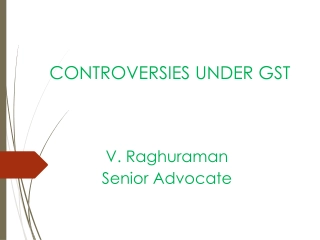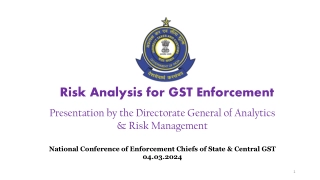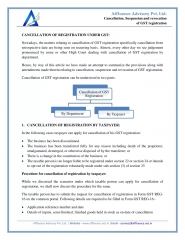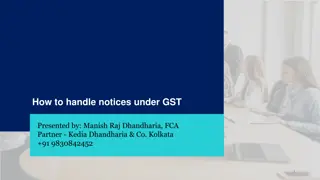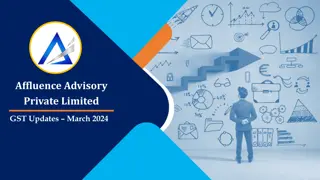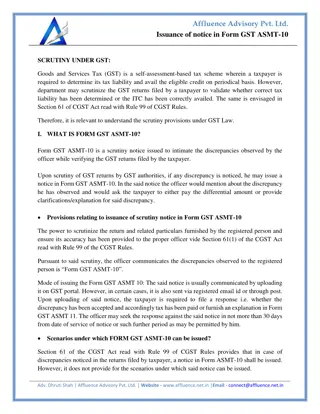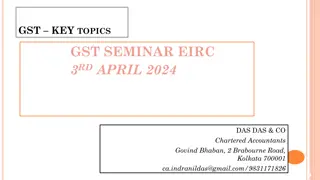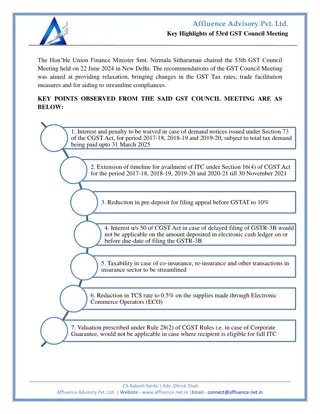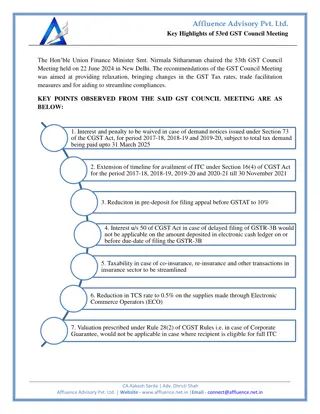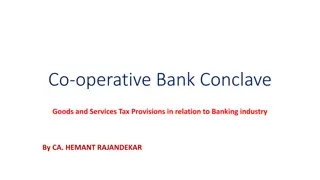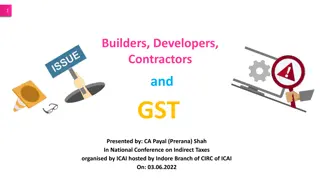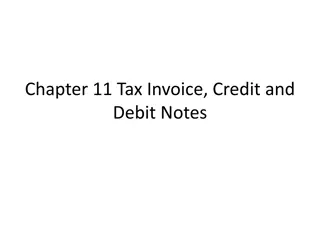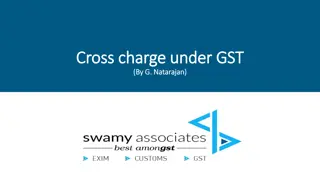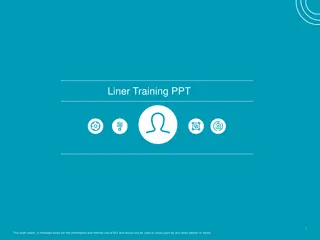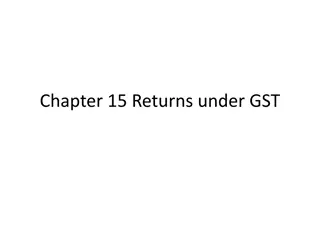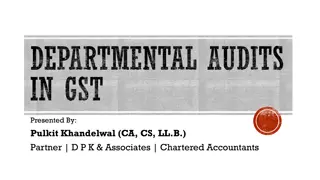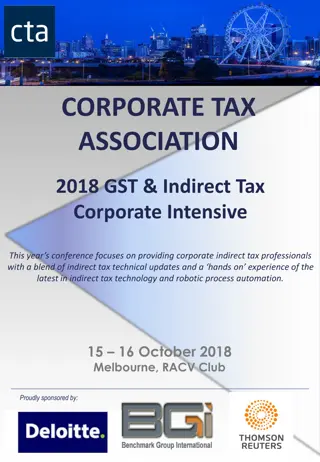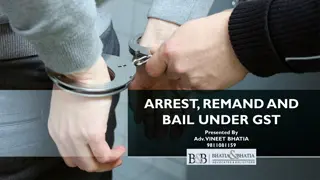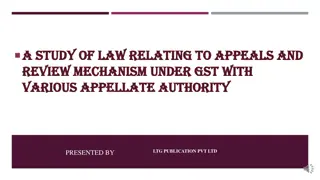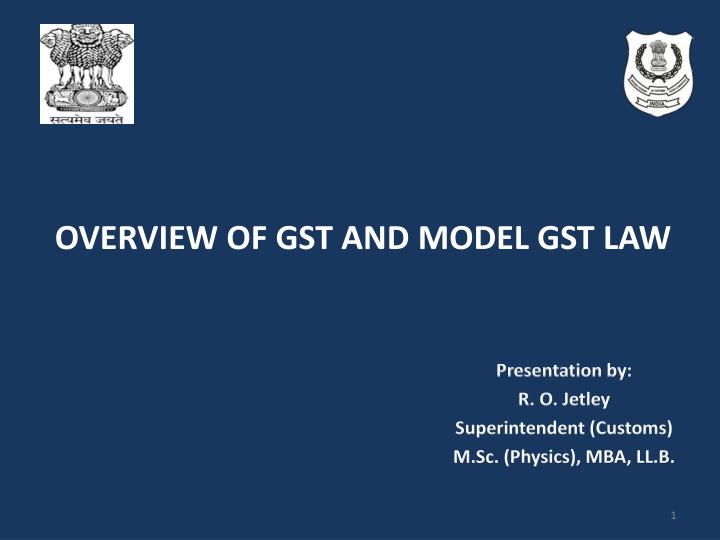
GST and Model GST Law Presentation by R. O. Jetley
Gain insights into Goods and Services Tax (GST) and the Model GST Law through a comprehensive presentation by R. O. Jetley, covering historical background, constitutional amendments, the current scenario, and the impact on taxation. Explore the transition from traditional tax systems to the GST regime.
Download Presentation

Please find below an Image/Link to download the presentation.
The content on the website is provided AS IS for your information and personal use only. It may not be sold, licensed, or shared on other websites without obtaining consent from the author. If you encounter any issues during the download, it is possible that the publisher has removed the file from their server.
You are allowed to download the files provided on this website for personal or commercial use, subject to the condition that they are used lawfully. All files are the property of their respective owners.
The content on the website is provided AS IS for your information and personal use only. It may not be sold, licensed, or shared on other websites without obtaining consent from the author.
E N D
Presentation Transcript
OVERVIEW OF GST AND MODEL GST LAW Presentation by: R. O. Jetley Superintendent (Customs) M.Sc. (Physics), MBA, LL.B. 1
DISCLAIMER THE OBJECTIVE OF TODAY S SEMINAR IS TO PROVIDE OVER ALL VIEW OF GOODS AND SERVICE TAX, BASED ON MODEL GST LAW. MOST OF THE ISSUES ARE YET TO BE FINALISED BY THE GST COUNCIL. CGST / IGST ACTS TO BE PASSED BY PARLIAMENT AND SGST ACT TO BE PASSED BY RESPECTIVE STATE LEGISLATURES. RULES AND REGULATIONS YET TO BE FRAMED. 2
PRESENT SCENARIO The Centre has the powers to levy tax on the manufacture of goods while the States have the powers to levy tax on the sale of goods. In case of inter-State sales, the Centre levies the Central Sales Tax but, the tax is collected and retained by States. As for services, it is the Centre alone that is empowered to levy service tax. Other taxes (e.g. Entertainment Tax) 4
AMENDMENT OF CONSTITUTION Need for amendment of Constitution Introduction of the GST required amendments in the Constitution so as to simultaneously empower the Centre and the States to levy and collect this tax. Constitution (101st Amendment) Act, 2016 Notifying different Sections of Constitution (101st Amendment) Act, 2016 Constitution of Goods & Service Tax Council 5
CONSTITUTION AMENDMENT The GST shall be levied on all goods and services, except alcoholic liquor for human consumption. (Petroleum Products shall be outside GST for initial period) The tax shall be levied as dual GST, separately by the Union and the States (As CGST & SGST). Parliament will have power to make laws with respect to CGST and State Legislatures will have power to make laws with respect to SGST. (This is yet to be done) Parliament will have exclusive power to make laws with respect to levy of IGST on inter-State trade or commerce. (This is yet to be done) GoI will have exclusive power to levy and collect IGST. This tax shall be apportioned between the Union and States. 6
Goods and Services Tax The GST would replace the following taxes currently levied and collected by the Centre: a. Central Excise duty b. Duties of Excise (Medicinal and Toilet Preparations) c. Additional Duties of Excise (Goods of Special Importance) d. Additional Duties of Excise (Textiles and Textile Products) e. Additional Duties of Customs (commonly known as CVD) f. Special Additional Duty of Customs (SAD) g. Service Tax h. Central Surcharges and Cesses so far as they relate to supply of goods and services 7
Goods and Services Tax State taxes that would be subsumed under the GST are: a. State VAT b. Central Sales Tax c. Luxury Tax d. Entry Tax (all forms) e. Entertainment and Amusement Tax (except when levied by the local bodies) f. Taxes on advertisements g. Purchase Tax h. Taxes on lotteries, betting and gambling i. State Surcharges and Cesses so far as they relate to supply of goods and services 8
OVERVIEW OF GST Petroleum & petroleum products would be subject to GST. Five petroleum products would be kept out of GST in initial years of implementation. In the case of tobacco and tobacco products, the Centre could levy excise duty in addition to GST. Taxes on entertainments and amusements to the extent levied and collected by a Panchayat/Municipality/Regional Council/District Council shall not be subsumed under GST. Parliament may, by law, provide for compensation to States for revenue loss arising out of implementation of GST. Such compensation could be for a maximum period of 5 years. 11
FUNCTIONS / POWERS OF GST COUNCIL A GST Council has been constituted comprising the Union Finance Minister, MoS (Revenue) and the State Finance/Taxation Ministers to recommend on: the taxes, cesses and surcharges to be subsumed under GST; goods and services that may be subjected to or exempted from GST; date from which the specified petroleum products would be subject to GST; model GST laws, principles of levy, apportionment of IGST and principles that govern the place of supply; threshold limit of turnover below which the goods and services may be exempted from GST; rates including floor rates with bands of GST; any special rate or rates for a specified period to raise additional resources during any natural calamity or disaster; and special provision with respect to NE States, J&K, HP and Uttarkhand. The GST Council may decide about the modalities to resolve disputes arising out of its recommendation. 12
BENEFITS OF GST The benefits of this transformational tax reform are manifold. The benefits include: A single tax would replace multiple taxes. Set-off of prior-stage taxes would mitigate the ill effects of cascading. Tax burden on goods and services would decrease, benefiting common man. Implementation of GST would make our products competitive in domestic and international markets. It would boost economic activity and create more jobs. The GDP would grow though the estimates in this regard vary. (It is estimated that GDP Growth will enhance by 1% by implementation of GST) 13
SALIENT FEATURES OF GST (1/4) The GST would be applicable on the supply of goods or services. It would be a destination based consumption tax. It would be a dual GST with the Centre and States simultaneously levying it on a common tax base. The GST to be levied by the Centre would be called Central GST (CGST) and that to be levied by States would be called State GST (SGST). The GST would apply to all goods other than alcoholic liquor for human consumption and five petroleum products. The GST would apply to all services barring a few to be specified. 14
SALIENT FEATURES OF GST (2/4) Tobacco and tobacco products would be subject to GST. In addition, the Centre could levy excise duty on these products. The GST would subsume numerous Central and State taxes. The CGST and SGST would be levied at rates to be jointly decided by the Centre and States. The rates would be notified on the recommendations of the GST Council. There would be a floor rate with a small band of rates within which the States may fix the rates for SGST. The exemption list would be common for the Centre and the States. 15
SALIENT FEATURES OF GST (3/4) An Integrated GST (IGST) would be levied and collected by the Centre on inter-State supply of goods and services. Tax payers shall be allowed to take credit of taxes paid on inputs (input tax credit) and utilize the same for payment of output tax. CGST credit can be used for payment of CGST and SGST credit can be used for payment of SGST. No ITC on account of CGST shall be utilized towards payment of SGST and vice versa. Credit of IGST would be permitted to be utilized for payment of IGST, CGST and SGST in that order. SGST portion of IGST shall be transferred to the destination State where the goods or services are eventually consumed. 16
SALIENT FEATURES OF GST (4/4) HSN code shall be used for classifying the goods under the GST regime. Taxpayers whose turnover is above Rs. 1.5 crores but below Rs. 5 crores shall use 2-digit code and the taxpayers whose turnover is Rs. 5 crores and above shall use 4-digit code. Exports shall be treated as zero-rated supply. No tax is payable on exports but ITC related to the supply shall be refunded to exporters. Import of goods/services would be subject to IGST in addition to customs duties. IGST paid shall be available as ITC for further transactions. Laws and procedures for levy and collection of CGST/SGST would be harmonized to the extent possible. 17
THRESHOLD EXEMPTION LIMIT Tax payers with an aggregate turnover in a financial year up to [Rs.20 lakhs] would be exempt from tax. For NE States and Sikkim, the threshold exemption shall be [Rs. 10 lakhs]. Tax payers making inter-State supplies or paying tax on reverse charge basis shall not be eligible for threshold exemption. 18
COMPOSITION SCHEME Small taxpayers with an aggregate turnover in a financial year up to [Rs. 50 lakhs] shall be eligible for composition levy. Under the Composition Scheme, a taxpayer shall pay tax as a percentage of his turnover during the year without the benefit of input tax credit (ITC). Tax payers making inter-State supplies or paying tax on reverse charge basis shall not be eligible for composition scheme. 19
OTHER LEGISLATIVE REQUIREMENTS Central GST Bill, Integrated GST Bill and State GST Bills drawing powers from the Constitution can be introduced in Parliament or the State Legislatures in Winter Session or in Special Session Unlike the Constitutional Amendment which required 2/3rd majority, the GST Bills would need to be passed by a simple majority. The levy of the tax can commence only after the GST law has been enacted by the respective legislatures. Unlike the State VAT, the date of commencement of this levy would need to be synchronized across the Centre and the States. This is because the IGST model cannot function effectively unless the Centre and all the States participate simultaneously. 20
Present modalities for taxation of inter state sales in VAT regime Centre levies CST on Inter-State Sales Art. 269 r/w Entry 92A of List I Collected & retained by originating State Entry Tax (Importing State) Art. 246 r/w Entry 52 of List II Some of the input tax credit (ITC) is retained by Exporting State Forms for accountal/verification of inter-state movement ITC of CST / Entry Tax not allowed to buying taxpayer 22
State Aa Origin state State Bb Destination State Utilisation of ITC payment lesser tax in cash to State B. So should get the amount from State A B2B B2C means of B ITC of tax paid on S is used for payment of GST on supplies Destination based tax belongs to State B GST is collected on supply S IGST further How would GST amount move from A to B
BASIC FEATURES of IGST LEVY oInterstate supplies to attract Integrated GST (IGST). o Interstate supplies to include imports and exports o IGST to apply on inter-state stock transfers of goods o ITC (IGST/CGST/SGST) fungibility to a large extent oCentre to levy & collect Integrated GST (IGST). oIGST shall be governed under the IGST Act 24
What IGST achieves Maintain integrity of ITC chain in interstate supplies 1 Tax inter-state supplies effectively while keeping the regime simple 2
GUIDING PRINCIPLES Clarity in Tax Laws Tax laws which are easy to administer Tax laws which are non-adversarial and tax-payer friendly Fair dispute resolution mechanism Improving Ease of Doing Business SOURCE MATERIAL Central Excise & Customs Law Service Tax Law State VAT Laws WTO Law 27
MEANING AND SCOPE OF SUPPLY Sec. 3 Under GST regime, tax is payable on the supply of goods and/or services. Supply includes All forms of supply made or agreed to be made for a consideration in the course or furtherance of business. Specified supplies made or agreed to be made without a consideration (Sch I : e.g. permanent transfer of business, services put to a private or non-business use etc.) Importation of service, whether or not for a consideration and whether or not in the course or furtherance of business. Transaction between a principal and agent shall be deemed to be a supply. Supply of any branded service by an aggregator under a brand name shall be deemed to be a supply. 28
TAXABLE PERSON Sec. 9 Means a person who is registered or required to be registered under Schedule III. Liability to pay tax arises only when the taxable person crosses the exemption threshold i.e. [Rs. 20 lakhs.] The Central / State Government and local authorities are regarded as taxable person. Persons who are not regarded as taxable persons under GST: an agriculturist an employee providing services to his employer person dealing with goods and/or services that are not liable to tax under the Act person receiving services of value not exceeding Rs .. in a year for personal use 29
VALUATION Sec. 15 Valuation to be done on the basis of transaction value. Transaction value is the price actually paid or payable for the goods and/or services. Transaction value shall, inter-alia, include: any taxes, duties, fees and charges levied under any statute other than CGST/SGST/IGST Act. incidental expenses such as commission, packing etc. charged by the supplier to the recipient of supply. royalties and licence fees related to the supply of goods and/or services. subsidies provided in any form or manner including subsidies provided by the Government. any discount or incentive that may be allowed after supply has been effected. 30
VALUATION.. Contd. Transaction value shall not include trade discounts allowed before or at the time of supply. Transaction value shall not include post supply discount which is given as per the agreement and is known at or before the time of supply. Where the value cannot be determined on the basis of transaction value, the same shall be determined in accordance with the Valuation Rules. Determination of value by comparison Computation method. Cost of production plus an amount towards profit and general expenses. Residual method using reasonable means consistent with the principles and general provisions of valuation rules. 31
INPUT TAX CREDIT(ITC) Sec. 16 ITC is available for business purposes and in respect of all taxable supplies. ITC is available on all goods other than goods and/or services in the negative list. Negative list comprises, inter alia, motor vehicles (except when they are used for certain purposes) goods and services provided in relation to food and beverages, outdoor catering, beauty treatment etc. goods and / or services on which tax has been paid under composition scheme Full ITC shall be allowed on capital goods on its receipt. 32
INPUT TAX CREDIT.. Contd. Manner of utilization of credit ITC on account of CGST shall first be utilized towards payment of CGST; the amount remaining, if any shall be utilized towards payment of IGST ITC on account of SGST shall first be utilized towards payment of SGST; the amount remaining, if any shall be utilized towards payment of IGST. No ITC on account of CGST shall be utilized towards payment of SGST and vice versa. ITC on account of IGST shall first be utilized towards payment of IGST; the amount remaining, if any shall be utilized towards payment of CGST and SGST, in that order. 33
REGISTRATION Schedule III & Chapter VI Liability to be registered Every person who is registered or who holds a license under an earlier law Every person whose turnover in a year exceeds Rs. [____ lakhs (18 or 19 Lakh, just below Rs. 20 Lakh] Liability to be registered irrespective of threshold Persons making inter-State taxable supply Persons required to pay tax under reverse charge Casual and non-resident taxable persons E-Commerce operator Persons who supply goods through e-commerce operator An aggregator who supplies services under his brand name Persons who supply goods and/or services on behalf of a registered taxable person. Input Service Distributor Persons required to deduct tax at source 34
REGISTRATION.. Contd. A person, though not liable to be registered, may take registration voluntarily [Sec. 19 (3)]. Registration to be granted State-wise. A person having multiple business verticals in a State may obtain separate registration [Sec. 19 (1) & (2)]. UN agencies, Multilateral Organizations, Embassies etc. shall be granted a Unique Identity Number instead of registration [Sec. 19 (6)]. Registration shall be approved by both the Central and State authorities. Registration shall be deemed to have been granted if no deficiency is communicated to the applicant within the prescribed period [Sec. 19 (9)]. Cancellation of registration under CGST Act means a cancellation of registration under SGST Act and vice-versa [Sec. 21 (6)]. 35
RETURN Chapter VIII Taxpayers shall file monthly returns. Return to be filed within 20 days after the end of tax period [Sec. 27 (1)]. Composition taxpayers shall file quarterly returns [Sec. 27 (1)]. ITC shall be provisionally allowed on filing of return (Sec. 28). Short-filing of return is allowed, but returns filed without payment of full tax shall not be treated as a valid return for allowing ITC in respect of supplies made by taxable person [Sec. 27 (3)]. Annual return to be filed on or before 31st December following the end of the financial year [Sec. 30 (1)] Audited statement of accounts and reconciliation statement to be submitted along with the Annual Return by certain taxable persons [Sec. 30 (2)]. 36
INVOICE MATCHING Sec. 29 & 29A After filing of return by the taxable person, his inward supplies and/or debit notes shall be matched with the corresponding outward supplies and/or debit notes declared by the supplier in his tax return. In case of matching, the ITC claimed by the taxable person shall be finally accepted and he shall be informed. In case of mis-match, the discrepancy shall be notified to the taxable person and his supplier. Where the supplier does not rectify the discrepancy in his return, the amount to the extent of discrepancy shall be added to the output tax liability of the taxable person. 37
INVOICE MATCHING..Contd. Likewise, the reduction in tax liability due to issue of a credit note by the supplier shall be matched with the reduction in ITC claimed by the recipient in his return. In case of matching, such reduction in the tax liability shall be finally accepted and communicated to the supplier. In case of mis-match, the discrepancy shall be notified to the supplier and the recipient. Where the recipient does not rectify the discrepancy and reduce his ITC claim in his return, the amount to the extent of discrepancy shall be added to the output tax liability of the supplier. A taxable person can reclaim the ITC reversed only after the concerned supplier furnishes the details of invoice and/or debit note in his return. 38
PAYMENT OF TAX Chapter IX Every deposit made by a taxable person shall be credited to the electronic cash ledger of such person [Sec. 35 (1)]. ITC as self assessed in the return of a taxable person shall be credited to his electronic credit ledger [Sec. 35 (2)]. Payment of tax is made by way of the debit in the electronic cash or credit ledger [Sec. 35 (3) & (4)]. Taxable person shall discharge his tax and other dues in the following order [Sec. 35 (8)]: Self-assessed tax, and other dues related to returns of previous tax periods; Self-assessed tax, and other dues related to returns of current tax period; and any other amount payable under the Act or rules made there under including the demand determined under section 51. 39
REFUNDS Sec. 38 Refund can be claimed within 2 years from the relevant date. Refund of ITC allowed in case of exports or where the credit accumulation is on account of inverted duty structure. 40
ASSESSMENT Sec. 44 & 44A Taxable person shall himself assess the taxes payable Taxable person may request for provisional assessment in cases where he is unable to determine the value or rate of tax Taxable person will have to furnish bond and security for availing this facility. Provisional assessment is to be finalized within 6 months After final assessment, the taxable person shall be liable to pay additional tax or may claim refund, as case may be 41
AUDIT Sec 49 Audit can be conducted at the place of business of the taxable person or at the office of the tax authorities. Taxable person shall be informed sufficiently in advance, prior to the conduct of audit. Audit shall be carried out in a transparent manner. Audit to be completed within 3 months, extendable by a further period of 6 months. On conclusion of audit, the proper officer shall without delay notify the taxable person of the findings, the taxable person s rights and obligations and reasons for the findings. 42
SEARCH, SEIZURE AND ARREST Sec. 60 & 62 Power to search places and seize goods, documents etc. has been retained under GST law. After seizure of goods, if notice is not given within 60 days, the goods shall be returned to the person. The period is extendable up to 6 months. A person can be arrested only where the amount of tax evaded exceeds Rs.50 lakh or where it is a repeat offence. If the amount of tax evaded exceeds Rs.2.5 crore, the offence is cognizable and non- bailable. If the amount of tax evaded is below Rs.2.5 crore, the offence is non-cognizable and bailable. Thus, the power to arrest is restricted under the GST Law. 43
PENALTY DISCIPLINES Sec. 68 21 offences as per Sec. 66, penalty provided in 66 & 67. No substantial penalties for minor breaches of tax regulations or procedural requirements. No penalty for any omission or mistake in documentation which is easily rectifiable and obviously made without fraudulent intent or gross negligence. Penalty shall be commensurate with the degree and severity of the breach. No penalty shall be imposed w/o issue of SCN and w/o giving PH. Reasoning to be given in the order, specifying the nature of the breach and the applicable laws or procedure. In case of voluntary disclosure of breach, the tax authorities may consider this fact as a potential mitigating factor when establishing a penalty for that person 44
PROSECUTION Sec. 73 OFFENCES PUNISHMENT Amount of tax evaded exceeds Rs.2.5 crore, and repeat offences. Amount of tax evaded exceeds Rs. 50 lakhs but does not exceed Rs.2.5 crore. 5 years imprisonment plus fine 3 years imprisonment plus fine 1 year imprisonment plus fine Amount of tax evaded exceeds Rs.25 lakhs but does not exceed Rs.50 lakhs. 12 major offences which warrant prosecution are given in Sec. 73 Punishment prescribed under the GST law is lesser as compared to the present provisions. 45
APPEALS Sec. 79 First appeal against any order passed by an adjudicating authority shall lie before the First Appellate Authority. Subsequent appeals lie before the Tribunal, High Court and Supreme Court. Pre-deposit of 10% of the amount in dispute for filing an appeal before the First Appellate Authority and Tribunal. The Department could request for higher amount of deposit in serious cases, where the disputed tax liability is Rs.25 crore or more. First Appellate Authority/Tribunal shall hear and decide the appeal within a period of 1 year, where it is possible to do so. 46
APPEALS..Contd. Appeal cannot be filed in the High Court against an order of the Appellate Tribunal. where two or more States or a State and the Centre have a difference of views regarding place of supply or where the matter involves two or more States or a State and Centre regarding treatment of transactions being intra-State or inter-State (Sec. 87), Certain decisions are not appealable (Sec. 93), viz., an order for transfer of proceeding from one officer to another officer. an order pertaining to seizure or retention of books of account, register and other documents. an order sanctioning prosecution under the Act. an order passed by the Commissioner allowing payment of tax dues in installments. 47
ADVANCE RULING Sec. 94 to 105 Advance ruling may be sought for classification, method of valuation, rate of tax, admissibility of ITC etc. Advance ruling is not to be given where the issue is already pending in the applicants case before any appellate forum. the same as in a matter already decided by the Appellate Tribunal or any Court. Advance ruling to be issued within 90 days. Advance ruling shall be binding only on the applicant and jurisdictional tax authorities. Advance ruling shall be binding unless there is a change in law or facts. Advance ruling shall be void in certain circumstances. 48
MODEL GST LAW: HIGHLIGHTS Registration shall be granted on line and shall be deemed to have been granted if no deficiency is communicated to the applicant within 3 working days [Sec. 19 (9)]. Taxable person shall himself assess the taxes payable (self- assessment) and credit it to the account of the Government (Sec. 44 & 27). Payment of tax shall be made electronically through internet banking (Sec. 35). Taxpayers shall furnish the details of sales and purchases electronically without any physical interface with the tax authorities (Sec. 25 & 26 ). Tax payers shall file, electronically, monthly returns. Composition tax payers shall file, electronically, Omission/incorrect particulars can be self-rectified before the filing of annual return (Sec. 27). quarterly returns. 49
MODEL GST LAW: HIGHLIGHTS.. Contd. Matching, reversal and reclaim of ITC shall be done electronically on the GSTN portal without any tax payer contact (Sec. 29 & 29A). Tax payers shall be allowed to keep and maintain accounts and other records in electronic form (Sec. 42). Tax payments for all months shall be made in the succeeding month. Tax dues of March are thus to be paid in April and not March, as at present in the Central Government (Sec. 27). New modes of payment of tax are being introduced, viz. through credit and debit cards, NEFT and RTGS (Sec. 35). Composition taxpayers shall pay tax on a quarterly basis in the month succeeding the quarter-end (Sec. 27). 50

